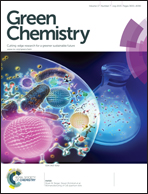Efficient hydration of 2-amino-2,3-dimethylbutyronitrile to 2-amino-2,3-dimethylbutyramide in a biphasic system via an easily prepared whole-cell biocatalyst†
Abstract
From an environmental perspective, utilizing nonconventional solvents (i.e. green solvents) with low ecological footprints is a highly beneficial alternative to using conventional organic solvents to form a reaction system. The nitrile hydratase (NHase, EC 4.2.1.84) catalyzed hydration of 2-amino-2,3-dimethylbutyronitrile (ADBN) to 2-amino-2,3-dimethylbutyramide (ADBA) in various green solvent–aqueous reaction systems was investigated in this study. After systematically optimizing the reaction conditions, the HFE-7100/H2O (v/v, 10%) biphasic system was ultimately identified as a promising reaction system for reducing product inhibition, avoiding substrate hydrolysis, and facilitating product separation and solvent recovery. The average ADBA yield of an entire batch reaction was 97.3%, which is obviously higher than those obtained with previously reported chemical or enzymatic methods. This is the first attempt to apply a fluorous solvent–aqueous biphasic system to a biocatalytic process, and the results suggest that the fluorous solvent employed in the biphasic system satisfies the requirements for green chemistry.


 Please wait while we load your content...
Please wait while we load your content...